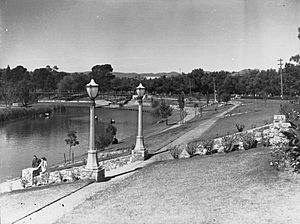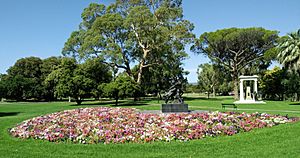Park 12 facts for kids
Park 12, also known by its Kaurna name Karrawirra, means "river red gum forest." It is one of the 29 beautiful Parks that make up the Adelaide Park Lands. This large park covers 55.5 hectares (about 137 acres). It is surrounded by important streets like North Terrace, Frome Road, Sir Edwin Smith Avenue, and King William Road.
The River Torrens flows right through the middle of Park 12, dividing it into two parts. The northern part of the park has playing fields used by the University of Adelaide. The southern part, along North Terrace, is home to many important buildings and landmarks. These include the University of South Australia (City East campus), the main campus of the University of Adelaide, the Art Gallery, the Museum, and the State Library. You can also find the War Memorial, Government House, and the Boer War Memorial here.
The southern part of Park 12 also features the Torrens Parade Ground, Jolly's Boat House, and several boathouses for rowing clubs. Within Park 12, you'll discover many special gardens and areas, such as Peace Park, Angas Gardens, Roberts Reserve, Grundy Gardens, the Cross of Sacrifice Garden, the South Australian Naval Memorial Garden, Lady Esther Lipman Gardens, Pioneer Women's Memorial Garden, Town Clerk’s Avenue/Walk, and the Pathway of Honour.
Contents
Buildings in Park 12
Park 12 is home to various buildings, many of which are used by the community or for park maintenance. Here are some of the main ones located north of Victoria Drive:
- Jolley's Boathouse Restaurant: A popular place to eat by the river.
- University Buildings: Several buildings and sheds are used by the University of Adelaide for sports and other activities.
- Rowing Club Boathouses: Many schools and clubs, like Prince Alfred College, Adelaide University, CBC, Torrens, Adelaide H.S., and St Peters College, have boathouses here for their rowing teams.
- Gardeners Sheds: Several sheds are used by the Adelaide City Council to store tools and equipment for maintaining the park.
- Pumphouse Bunker: Another structure managed by the Adelaide City Council.
- Sewer Vent House: A functional building managed by SA Water.
University Footbridge
The University Footbridge is a beautiful bridge that crosses the River Torrens within the park. It was designed by engineers John Adrian Farghar and Reginald Bridgland from the South Australian Railways department. The bridge opened on August 9, 1937, as part of the state's centenary celebrations. It was built with money from the Council and a generous gift from Misses E and L Waite. This footbridge is now recognized as a State Heritage Place, meaning it's an important historical landmark.
Formal Parks, Gardens, and Paths
Park 12 features several specially designed gardens and pathways, each with its own history and purpose.
Pathway of Honour
This pathway is located between Kintore Avenue and King William Road, next to the wall of Government House. It's a narrow, curved path with special plaques and stones that honor those who died in war. It became a formal memorial path in the 1980s, but people had been using it as a route since the 1920s.
Town Clerk’s Avenue / Walk
This is a straight pedestrian path that connects Sir Edwin Smith Avenue and Angas Gardens to Frome Road. It was created around 1917 with trees planted along its sides, making it a pleasant walk.
Angas Gardens
You can find Angas Gardens east of King William Road, between War Memorial Drive and the River Torrens. The gardens are named after John Howard Angas and George Fife Angas, who were important pioneers and pastoralists in South Australia. Here, you'll see the JH & GF Angas Statue and Memorial by WR Cotton (from 1915). There's also a famous statue by Robert Hannaford called "Simpson and his donkey", which tells a story of bravery during wartime.
Roberts Place
Located at the corner of Frome Road and Sir Edwin Smith Avenue, Roberts Place is a triangular piece of land. It was originally planned as a formal garden with a large Moreton Bay Fig tree at its center. It is named after Josiah Roberts, an American merchant and a commissioner for the colonization of South Australia.
Grundy Gardens
Grundy Gardens is situated between Frome and King William Roads, and War Memorial and Victoria Drives. It's another green space within Park 12 where people can relax.
Pennington Gardens East
This triangular garden is located between King William Road, Pennington Terrace, and Sir Edwin Smith Avenue. Its design changed significantly after 1919 when the Women’s War Memorial Garden was added. It is named after James Pennington, another South Australian Colonisation Commissioner.
Women’s War Memorial Garden
Inside Pennington Gardens East, you'll find the Women’s War Memorial Garden, designed by Walter Torode in 1922. This garden has a formal, rectangular shape, similar to a cathedral floor plan, and is known as the 'Cross of Sacrifice' Garden. It was designed by architect Alfred Wells and garden designer Sir Herbert Baker. The garden features low Olive hedges, Lavender, and Roses.
At one end stands the 11.6-meter (38-foot) high Cross of Sacrifice, designed by Sir Reginald Blomfield. It faces St Peter's Cathedral. A scroll with the names of Adelaide's fallen soldiers is placed inside the base of the cross as a tribute. At the other end is the Remembrance Stone, designed by Sir Edwin Lutyens. The Cross was unveiled and the Garden opened on April 25, 1922, and the Stone was unveiled on April 25, 1923. The annual Anzac Day Commemorative March in Adelaide finishes at this War Memorial. This garden is also listed as a State Heritage Place.
Pioneer Women’s Memorial Garden
This garden is located within the Torrens Parade Ground area, between the Parade Ground and the northern wall of Government House. In 1937, the Women’s Council of South Australia suggested this spot to honor the pioneer women of South Australia. A committee led by Adelaide Miethke helped make it happen. The statue, made of Waikerie limestone, was sculpted by Olna Cohn. The garden itself was designed, planted, and built by landscape designer Elsie Cornish in 1938. The statue was unveiled on April 19, 1941. The Council renovated the garden in 2002. This garden is important because of its connection to the founding of the Royal Flying Doctor Service in Alice Springs. It is also a State Heritage Place.
Heritage Rose Garden
Developed between 1995 and 1996, and then re-developed in 2017-2018, this garden is located on the north bank of the River Torrens. It was designed by the Heritage Roses in Australia, Adelaide group, and is a beautiful place to see many different types of roses.




